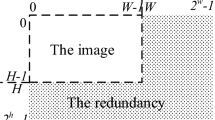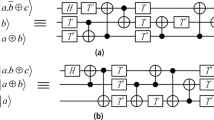Abstract
The smart home has security problems such as information leakage during file transmission, beyond the classical cryptographic scheme, quantum cryptography provides new solutions. A scheme for quantum-controlled dense coding with an extended GHZ state is investigated. In the home Internet of Things, monitoring devices, display devices, and home gateways complete the encrypted transmission of video files through the shared GHZ state. The method divided the file signature and the data part of the video file, utilizes quantum-controlled dense coding to form a sequence of encoded data packets, and reorders the data packets in sequence before transmission to ensure the security of data transmission. Experimental analysis shows that the scheme achieves high fidelity of \(99.95\%\) under the condition of adding noise. According to the nature of dense coding and no-cloning theorem, this scheme has high transmission efficiency and low computational cost and can realize the safe transmission of video files in a restricted environment.







Similar content being viewed by others
Data Availability
Data underlying the results presented in this paper are not publicly available at this time but may be obtained from the authors upon reasonable request.
References
Dziubinski, K., & Bandai, M. (2021). Bandwidth efficient IoT traffic shaping technique for protecting smart home privacy from data breaches in wireless LAN. IEICE Transactions on Communications, E104(8), 961–973.
Azadmanesh, M., Mahdavi, M., & Ghahfarokhi, B. S. (2020). A reliable and efficient micro-protocol for data transmission over an RTP-based covert channel. Multimedia Systems, 26, 15.
Xiong, Y. (2006). Covert communication audio watermarking algorithm based on LSB. In International conference on communication technology (pp. 1–4).
Miao, R., & Huang, Y. (2011). An approach of covert communication based on the adaptive steganography scheme on Voice over IP. In 2011 IEEE International conference on communications (pp. 1–5).
Wang, Z., Feng, G., Ren, Y., & Zhang, X. (2020). Multichannel steganography in digital images for multiple receivers. IEEE Multimedia, 99, 65–73.
Zong, J., Hajomer, A., & Zhang, L. (2020). Real-time secure optical OFDM transmission with chaotic data encryption. Optics Communications, 473, 126005.
Jayanthi, R., & Singh, K. J. (2019). A public key-based encryption and signature verification model for secured image transmission in network. International Journal of Internet Technology and Secured Transactions, 9(3), 299–312.
Li, Y., Zhang, P., & Huang, R. (2019). Lightweight quantum encryption for secure transmission of power data in smart grid. IEEE Access, 7, 36285–36293.
Lampson, B. W. (1973). A note on the confinement problem. Communications of the ACM, 16(10), 613–615.
Raesh, H., & Anjan, K. (2015). Construction of covert channel using data hiding mechanism in Ipv 4. IJRCCT, 4(6), 387–389.
Mstafa, R. J., & Elleithy, K. M. (2015). A high payload video steganography algorithm in DWT domain based on BCH codes. In Wireless telecommunications symposium (pp. 1–8).
Ma, L., Sun, X., & Jin, W. (2020). Symmetric-asymmetric hybrid encryption and decryption system based on chaotic iris phase mask and computer-generated holography. Optical Engineering, 59, 8.
Ye, G., Jiao, K., & Huang, X. (2021). Quantum logistic image encryption algorithm based on SHA-3 and RSA. Nonlinear Dynamics, 104, 2807–2827.
Asharov, G., Segev, G., & Shahaf, I. (2021). Tight tradeoffs in searchable symmetric encryption. Journal of Cryptology, 34, 2.
Backes, M., & Pfitzmann, B. (2004). Symmetric encryption. In 17th IEEE computer security foundations workshop (Vol. 3, pp. 204–218).
Boykin, P. O., & Roychowdhury, V. (2003). Optimal encryption of quantum bits. Physical Review A, 67(4), 042317.
Lai, C. Y., & Chung, K. M. (2019). Quantum encryption and generalized Shannon impossibility. Codes and Cryptography, 87(9), 1961–1972.
Yu, S., & Sun, C.-P. (2000). Canonical quantum teleportation. Physical Review A, 61(2), 022310.
Modławska, J., & Grudka, A. (2009). Adaptive quantum teleportation. Physical Review A, 79(6), 064302.
Luo, Y. H., Zhong, H. S., & Erhard, M. (2019). Quantum teleportation in high dimensions. Physical Review Letters, 123(7), 070505.
Gao, C.-H., Guo, Y., Jiang, D., Liu, J., & Chen, L.-J. (2020). Multimatrix rate-compatible reconciliation for quantum key distribution. Physical Review A, 102(2), 022604.
Christandl, M., Ferrara, R., & Horodecki, K. (2021). Upper bounds on device-independent quantum key distribution. Physical Review Letters, 126(16), 160501.
Bennett, C. H., & Wiesner, S. J. (1992). Communication via one-and two-particle operators on Einstein–Podolsky–Rosen states. Physical Review Letters, 69(20), 2881.
Hao, J. C., Li, C. F., & Guo, G. C. (2001). Controlled dense coding using the Greenberger–Horne–Zeilinger state. Physical Review A, 63(5), 054301.
Shi, S., Tian, L., Wang, Y., Zheng, Y., Xie, C., & Peng, K. (2020). Demonstration of channel multiplexing quantum communication exploiting entangled sideband modes. Physical Review Letters, 125(7), 070502.
Moreno, G., Nery, R., de Gois, C., Rabelo, R., & Chaves, R. (2021). Semi-device-independent certification of entanglement in superdense coding. Physical Review A, 103(2), 022426.
Grover, L. K. (2000). Synthesis of quantum superpositions by quantum computation. Physical Review Letters, 85(6), 1334–1337.
Hadjiivanov, L., & Todorov, I. (2015). Quantum entanglement. New Journal of Physics, 4(1), 73.
Luo, S., & Sun, Y. (2017). Quantum coherence versus quantum uncertainty. Physical Review A, 96(2), 022130.
Tambini, U., Presilla, C., & Onofrio, R. (1995). Dynamics of quantum collapse in energy measurements. Physical Review A, 51(2), 967–975.
Koashi, M., & Imoto, N. (1998). No-cloning theorem of entangled states. Physical Review Letters, 81(19), 4264–4267.
Lutz, M. J. (2004). Integrated Broadband Networks: TCP/IP, ATM, SDH/SONET, and WDM/Optics [Book Review][J]. Computer, 35(10), 72.
Nielsen, M. A., & Chuang, I. (2002). Quantum computation and quantum information. Mathematical Structures in Computer Science, 17(6), 1115.
Acknowledgements
The work is supported by was supported by the Shandong Province Higher Educational Science and Technology Program (No. J18KZ012), and the National Natural Science Foundation of China (Nos. 11975132, 61772295), and the Shandong Provincial Natural Science Foundation, China (No. ZR2019YQ01).
Author information
Authors and Affiliations
Corresponding author
Ethics declarations
Conflict of interest
The authors declare that there are no conflicts of interest related to this article.
Additional information
Publisher's Note
Springer Nature remains neutral with regard to jurisdictional claims in published maps and institutional affiliations.
Rights and permissions
About this article
Cite this article
Ma, H., Ma, Y., Zhang, W. et al. Development of Video Encryption Scheme Based on Quantum Controlled Dense Coding Using GHZ State for Smart Home Scenario. Wireless Pers Commun 123, 295–309 (2022). https://doi.org/10.1007/s11277-021-09132-5
Accepted:
Published:
Issue Date:
DOI: https://doi.org/10.1007/s11277-021-09132-5




